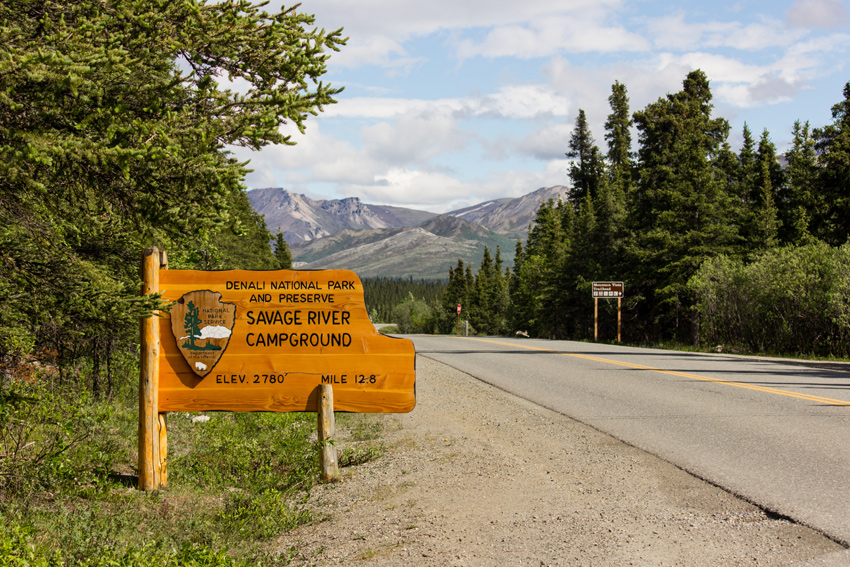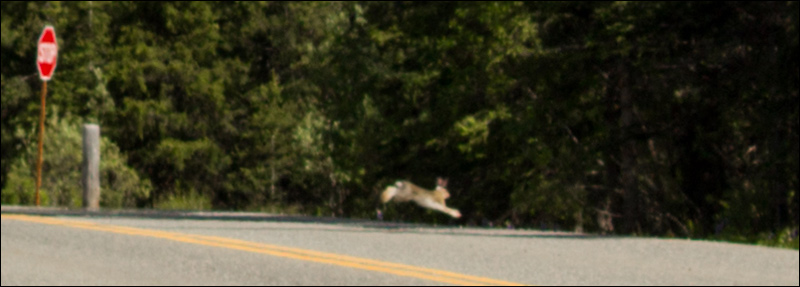Trees and a scenic mountain vista surrounding the wooden Savage River Campground sign as a snowshoe hare (Lepus americanus) dashes across Denali Park Road.
MP 12.8 Denali Park Road, Denali National Park and Preserve, Alaska: 17 June 2017
part of the Alaska 2017: Denali National Park and Preserve album
Back in February 2017, while assembling a daily travel guide for my Alaska adventure in June, I came across a nice photograph to represent our Savage River Campground reservation in Denali National Park and Preserve. Taken by Sue Thomas and appearing on her Yukon Sights website, the photograph shows the campground's wooden sign among the surrounding trees and mountains. It was an image I knew I wanted to capture myself once there.
Late in the afternoon on our third day in Denali, we returned to the campground in order to hike the adjacent Mountain Vista Trail. As we approached the entrance, I noticed that the weather had finally cleared up enough to make the photograph I wanted possible. We pulled over and I ran to the sign, quickly shooting three frames. I thought that there was some brief movement but seeing nothing around, I returned to the truck and we continued on to our site and then the trail.
The movement that I detected turned out to be a snowshoe hare (Lepus americanus) bolting across the road at the moment I took my pictures. The hare appears in the distance near a stop sign in the first two of three shots. Even though that third frame is slightly better, I developed the second instead. Considering my deliberate efforts to photograph wildlife, the good fortune of unintentionally capturing an animal is just too good to pass up.
I saw many snowshoe hares throughout Alaska, with the densest populations observed between Coldfoot and Wiseman along the Dalton Highway. Not coincidentally, this is the area where we spotted a Canada lynx (Lynx canadensis), whose diet primarily consists of snowshoe hare.









What do you mean when you say, "I developed the second instead"? What is the process of developing a digital photograph?
The process by which digital photographs are developed is similar to how film negatives are developed into prints.
First, the photographs must be taken using the camera's raw mode, which will create a raw image file for each exposure. This file is not a usable photo but contains all of the information needed to create one. Next, the raw files are imported into a program for processing. I use Adobe Lightroom 6 for my workflow, which includes image development and the addition of titles, captions, keyword tags and GPS coordinates. Lightroom has all of the tools available in a photographer's darkroom but in a digital format and without the chemical odor.
When the raw files are imported into Lightroom, they are displayed using all of the data captured by the camera's sensor but the images appear dull and flat. Using the tools, I am able to make adjustments to the photograph parameters — white balance, color temperature, exposure, shadows, highlights and more — to make it appear as true to life as possible or in some cases produce something a little more artistic. The software also allows for straightening, cropping and spot removal. When finished, I export a JPEG version of the photo which is uploaded to the Gallery.
At the end of this process, I have three items. Like a film negative, the raw file remains untouched. Like a print, the JPEG provides a viewable and sharable representation of the photograph. And in between these two, the development parameters are saved in Lightroom's database. This way no data is ever lost or overwritten. I always have the option of returning to the raw image file and developing a new photograph from it (see "The Way You Look Tonight" for an example of three photographs produced from a single raw exposure). When I said that "I developed the second instead", I meant that raw file two of three was imported into Lightroom for post-processing and export to JPEG.
How does it work if you take non-raw pictures? When shooting straight to JPEG, the raw exposure is immediately processed by the camera and the results saved to a JPEG; a one-time automated interpretation of the scene. While this does provide speed and convenience like a Polaroid, no record of the complete sensor data ("negative") exists for that photograph. Any corrections made to it in post-production will be hindered by this lack of data.
How much more data does a raw image file have than a JPEG? This will vary based on a wide range of factors. My raw image files are generally between twenty and thirty megabytes each, while the exported JPEGs probably average between eight and fourteen megabytes. JPEGs produced by cameras directly are possibly even smaller than that. Using the photograph in this article as an example, the raw file is 29,445,772 bytes and the exported JPEG version is 12,624,233 bytes.
Thanks for the enlightening explanation. I think you must singlehandedly keep the manufacturers of external drives in business.
Not at all. I have three and two of them are copies of each other.
I had no idea that the images were developed. Now the enormity of the project of posting and writing text for as many images makes me think of Mount Denali.